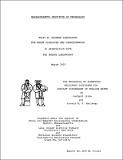| dc.contributor.author | Jirka, Gerhard H. | |
| dc.contributor.author | Harleman, Donald R. F. | |
| dc.date.accessioned | 2005-09-15T14:53:29Z | |
| dc.date.available | 2005-09-15T14:53:29Z | |
| dc.date.issued | 1973 | |
| dc.identifier.other | 19867223 | |
| dc.identifier.uri | http://hdl.handle.net/1721.1/27273 | |
| dc.description | Prepared by the Ralph M. Parsons Laboratory for Water Resources and Hydrodynamics in association with the Energy Laboratory | en |
| dc.description.abstract | A submerged multiport diffuser is an effective device for disposal
of water containing heat or other degradable wastes into a natural body
of water. A high degree of dilution can be obtained and the environmental impact of concentrated waste can be constrained to a small area.
An analytical and experimental investigation is conducted for the
purpose of developing predictive methods for buoyant discharges from submerged multiport diffusers. The following physical situation is considered:
A multiport diffuser with given length, nozzle spacing and vertical angle
of nozzles is located on the bottom of a large body of water of uniform
depth. The ambient water is unstratified and may be stagnant or have a
uniform current which runs at an arbitrary angle to the axis of the diffuser. The general case of a diffuser in arbitrary depth of water and
arbitrary buoyancy is treated. However, emphasis is put on the diffuser
in shallow receiving water with low buoyancy, the type used for discharge
of condenser cooling water from thermal power plants.
A multiport diffuser will produce a general three-dimensional
flow field. Yet the predominantly two-dimensional flow which is postulated to exist in the center portion of the three-dimensional diffuser
cart be analyzed as a two-dimensional "channel model", that is a diffuser
section bounded by walls of finite length and openings at both ends
into a large reservoir. Matching of the solutions for the four distinct
flow regions which can be discerned in the channel model, namely, a
buoyant jet region, a surface impingement region, an internal hydraulic
jump region and a stratified counterflow region, yields these results:
The near-field zone is stable only for a limited range of jet densimetric
Froude numbers and relative depths. The stability is also dependent on
the jet discharge angle. It is only in this limited range that previous
buoyant jet models assuming an unbounded receiving water are applicable
to predict dilutions. Outside of the parameter range which yields
stable near-field conditions, the diffuser-induced dilutions are essentially determined by the interplay of two factors: frictional effects
in the far-field and the horizontal momentum input of the jet discharge.
Three far-field flow configurations are possible, a counter flow system,
a stagnant wedge system and a vertically fully mixed flow, which is the
extreme case of surface and bottom interaction.
A three-dimensional model for the diffuser-induced flow field is
developed. Based on equivalency of far-field effects, the predictions
of the two-dimensional channel model can be linked to the three-dimensional diffuser characteristics. Diffusers with an unstable near-field
produce three-dimensional circulations which lead to recirculation at
the diffuser line: effective control of these circulations is possible
through horizontal nozzle orientation.
The diffuser in an ambient cross-current is studied experimentally.
Different extreme regimes of diffuser behaviour can be described. Performance is dependent on the arrangement of the diffuser axis with respect to the crossflow direction.
Experiments are performed in two set-ups, investigating both two-
dimensional slots and three-dimensional diffusers. Good agreement between
theoretical predictions and experimental results is found.
The results of this study are presented in form of dilution graphs
which can be used for three-dimensional diffuser design or preliminary
design if proper schematization of the ambient geometry is possible.
Design considerations are discussed and examples are given. For more
complicated ambient conditions, hydraulic scale models are necessary.
The results of this study indicate that only undistorted scale models
simulate the correct areal extent of the temperature field and the interaction with currents, but are always somewhat conservative in dilution
prediction. The degree of conservatism can be estimated. Distorted
models are less conservative in predicting near-field dilutions, but
exaggerate the extent of the near-field mixing zone. | en |
| dc.description.sponsorship | Stone and Webster Engineering Corp., Boston, Mass., Long Island Lighting Co., Hicksville, New York, and the National Science Foundation, Engineering Energetics Program. GK-32472 | en |
| dc.format.extent | 12248695 bytes | |
| dc.format.mimetype | application/pdf | |
| dc.language.iso | en_US | en |
| dc.publisher | MIT Energy Lab | en |
| dc.relation.ispartofseries | MIT-EL | en |
| dc.relation.ispartofseries | 73-014 | en |
| dc.subject | Waste heat | en |
| dc.subject | Thermal pollution of rivers, lakes | en |
| dc.subject | Diffusers | en |
| dc.subject | Two-phase flow | en |
| dc.subject | Buoyant ascent (Hydrodynamics) | en |
| dc.title | The mechanics of submerged multiport diffusers for bouyant discharges in shallow water | en |
| dc.type | Technical Report | en |
